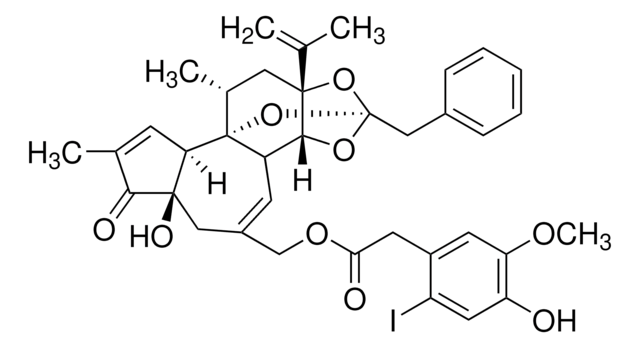R8756
Resiniferatoxin
from Euphorbia poisonii, ~95%
About This Item
Productos recomendados
origen biológico
Euphorbia poisonii
Nivel de calidad
Ensayo
~95%
temp. de almacenamiento
−20°C
cadena SMILES
[H][C@@]12C=C(C)C(=O)[C@@]1(O)CC(COC(=O)Cc3cc(O)cc(OC)c3)=CC4[C@H]5O[C@]7(Cc6ccccc6)O[C@]5(C[C@@H](C)[C@]24O7)C(C)=C
InChI
1S/C37H40O9/c1-21(2)35-17-23(4)37-29(33(35)44-36(45-35,46-37)19-24-9-7-6-8-10-24)14-26(18-34(41)30(37)11-22(3)32(34)40)20-43-31(39)15-25-12-27(38)16-28(13-25)42-5/h6-14,16,23,29-30,33,38,41H,1,15,17-20H2,2-5H3/t23-,29?,30-,33-,34-,35-,36-,37-/m1/s1
Clave InChI
IKYCZSUNGFRBJS-PMIKMUNESA-N
Información sobre el gen
rat ... Trpv1(83810)
Aplicación
- for complex preparation for cryo-electron microscopy structural studies[1]
- to test its effect towards immune responses to P. aeruginosa in sensory neurons associated with the cornea[2]
- to study its effects in the denervation of the peripheral sensory nerves in psoriatic mice[3]
Acciones bioquímicas o fisiológicas
Palabra de señalización
Danger
Frases de peligro
Clasificaciones de peligro
Acute Tox. 3 Oral - Skin Corr. 1A
Código de clase de almacenamiento
6.1C - Combustible acute toxic Cat.3 / toxic compounds or compounds which causing chronic effects
Clase de riesgo para el agua (WGK)
WGK 3
Punto de inflamabilidad (°F)
Not applicable
Punto de inflamabilidad (°C)
Not applicable
Equipo de protección personal
Eyeshields, Faceshields, Gloves, type P3 (EN 143) respirator cartridges
Elija entre una de las versiones más recientes:
¿Ya tiene este producto?
Encuentre la documentación para los productos que ha comprado recientemente en la Biblioteca de documentos.
Los clientes también vieron
Filtros activos
Nuestro equipo de científicos tiene experiencia en todas las áreas de investigación: Ciencias de la vida, Ciencia de los materiales, Síntesis química, Cromatografía, Analítica y muchas otras.
Póngase en contacto con el Servicio técnico










